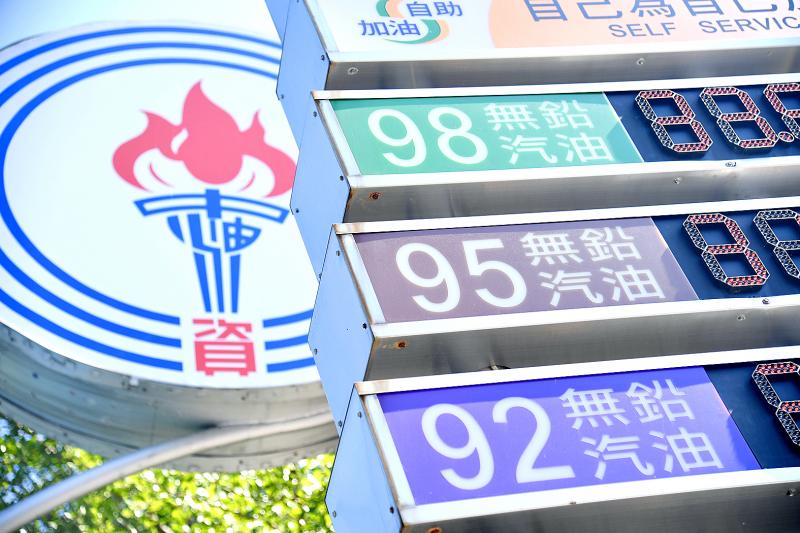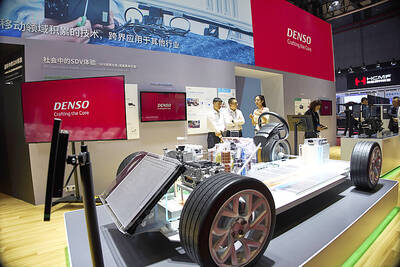State-owned oil supplier CPC Corp, Taiwan (CPC, 台灣中油) plans to build a new naphtha cracker in Kaohsiung to replace its No. 4 cracker at a cost of NT$82.3 billion (US$2.89 billion), CPC spokesman Chang Ray-chung (張瑞宗) said on Sunday.
The No. 4 cracker in Linyuan District (林園) has been operating for 37 years and has an annual ethylene production capacity of 380,000 tonnes, which cannot meet demand, Chang said.
Given robust demand for basic chemical raw materials and potential demand from a new circular industrial park being developed in Siaogang District’s (小港) Dalinpu Village (大林蒲), which is focused on innovative materials, CPC has decided to build a new naphtha cracker to sustain an adequate supply, Chang said.

Photo: CNA
The company is required to build a new plant before it dismantles the old one, and finding a site for the new plant was a pressing issue, he said.
For the project, CPC chose a 31 hectare plot it purchased in 2017 from chemicals manufacturer China American Petrochemical Co Ltd (中美和石化).
CPC plans to apply for an environmental impact assessment next year, and hopes to break ground in 2025 and begin production in 2028, Chang said.
The new plant is expected to produce 1 million tonnes of ethylene per year, 163 percent more than produced at the current facility, he said.
Separately, Formosa Plastics Corp (台灣塑膠) last week said that it plans to invest about US$3.6 billion in Taiwan, China and the US over the next five years to expand its production capacity.
The company said the investment is aimed at tapping the expected global recovery in the post-COVID-19 era.
Most of the funds would go to the US, where the company is considering investing US$2.92 billion in its plant in Texas to raise annual production of polyvinyl chloride (PVC), vinyl chloride monomer (VCM) and caustic soda by 800,000 tonnes, 800,000 tonnes and 560,000 tonnes respectively.
In Taiwan, the company would spend NT$350 million to help subsidiary Taiwan VCM Corp (台灣氯乙烯) expand its PVC production capacity by 100,000 tonnes a year, which is scheduled to be completed by the end of next year, Formosa Plastics said.
Another NT$8.85 billion would be spent to build 12 storage tanks and a warehouse in Kaohsiung, with construction scheduled to be completed by March next year, the company said, adding that NT$200 million would be invested in its superabsorbent polymer plant in Chiayi County to boost production by 20,000 tonnes a year.
Formosa Plastics plans to invest US$40 million in its Ningbo plant in China to increase the production of ethylene vinyl acetate by 28,000 tonnes a year, it said, adding that the work is expected to be completed by December next year.
The company said that it is also studying the feasibility of investing US$360 million in Ningbo to raise annual PVC and VCM production by 150,000 tonnes and 600,000 tonnes respectively.

GROWING OWINGS: While Luxembourg and China swapped the top three spots, the US continued to be the largest exposure for Taiwan for the 41st consecutive quarter The US remained the largest debtor nation to Taiwan’s banking sector for the 41st consecutive quarter at the end of September, after local banks’ exposure to the US market rose more than 2 percent from three months earlier, the central bank said. Exposure to the US increased to US$198.896 billion, up US$4.026 billion, or 2.07 percent, from US$194.87 billion in the previous quarter, data released by the central bank showed on Friday. Of the increase, about US$1.4 billion came from banks’ investments in securitized products and interbank loans in the US, while another US$2.6 billion stemmed from trust assets, including mutual funds,

AI TALENT: No financial details were released about the deal, in which top Groq executives, including its CEO, would join Nvidia to help advance the technology Nvidia Corp has agreed to a licensing deal with artificial intelligence (AI) start-up Groq, furthering its investments in companies connected to the AI boom and gaining the right to add a new type of technology to its products. The world’s largest publicly traded company has paid for the right to use Groq’s technology and is to integrate its chip design into future products. Some of the start-up’s executives are leaving to join Nvidia to help with that effort, the companies said. Groq would continue as an independent company with a new chief executive, it said on Wednesday in a post on its Web

JOINT EFFORTS: MediaTek would partner with Denso to develop custom chips to support the car-part specialist company’s driver-assist systems in an expanding market MediaTek Inc (聯發科), the world’s largest mobile phone chip designer, yesterday said it is working closely with Japan’s Denso Corp to build a custom automotive system-on-chip (SoC) solution tailored for advanced driver-assistance systems and cockpit systems, adding another customer to its new application-specific IC (ASIC) business. This effort merges Denso’s automotive-grade safety expertise and deep vehicle integration with MediaTek’s technologies cultivated through the development of Media- Tek’s Dimensity AX, leveraging efficient, high-performance SoCs and artificial intelligence (AI) capabilities to offer a scalable, production-ready platform for next-generation driver assistance, the company said in a statement yesterday. “Through this collaboration, we are bringing two

Even as the US is embarked on a bitter rivalry with China over the deployment of artificial intelligence (AI), Chinese technology is quietly making inroads into the US market. Despite considerable geopolitical tensions, Chinese open-source AI models are winning over a growing number of programmers and companies in the US. These are different from the closed generative AI models that have become household names — ChatGPT-maker OpenAI or Google’s Gemini — whose inner workings are fiercely protected. In contrast, “open” models offered by many Chinese rivals, from Alibaba (阿里巴巴) to DeepSeek (深度求索), allow programmers to customize parts of the software to suit their